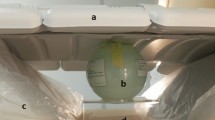Abstract
To calibrate magnetic resonance (MR) signal intensity that depends on radio frequency (RF) coil loading, the transmission amplitude (TRA) for the excitation in the transmit-receive RF coil has been used as a good index in the so-called TRA method. As this TRA method needs neither an internal reference nor an additional external reference for the calibration, its accuracy is free from reference measurements. This study elucidated the calibration accuracy of MR signal intensities based on the TRA method. A cylindrical gel phantom was used for accuracy measurements with a 1.5-T MRI unit with conventional TI imaging as a simple pulse sequence for various loading conditions. The brain parenchyma of eight healthy volunteers also showed calibrated MR signal deviations. The error of the phantom calibration measurements was 2.18% (S.D.%). The background noise intensity of images was theoretically derived to correlate with the impedance mismatching of the RF coil, which is inevitable for fixed tuning, even for automatic tuning that is not always exact. Taking into account this noise intensity, the calibration method was modified to reduce its error to 1.50%. The standard deviations of the calibrated values in the thalamus and frontal white matter were 2.9 and 3.8%. respectively. We suggest that the modified TRA method is a practical and reliable technique to obtain clinical numeric evidence.
Similar content being viewed by others

References
Kitagaki H, Mori E, Hirono N, et al. Alteration of white matter MR signal intensity in frontotemporal dementia. Am J Neuroradiol 1997;18:367–78.
Honda H, Kaneko K, Kanazawa Y, et al. MR imaging of hepatocellular carcinomas: effect of Cu and Fe contents on signal intensity. Abdom Imaging 1997;22:60–6.
Ernst T, Kreis R, Ross BD. Absolute quantification of water and metabolites in the human brain. I. Compartments and water. J Magn Reson [B] 1993;102:1–8.
Narayana PA, Fotedar LK, Jackson EF, Bohan TP, Butler IJ, Wolinsky JS. Regional in vivo proton magnetic resonance spectroscopy of brain. J Magn Reson 1989;83:44–52.
Hennig J, Pfister H, Ernst T, Ott D. Direct absolute quantification of metabolites in the human brain with in vivo localized proton spectroscopy. NMR Biomed 1992;5:193–9.
Husted CA, Duijn JH, Matson GB, Maudsley AA, Weiner MW. Molar quantitation of in vivo proton metabolites in human brain with 3D magnetic resonance spectroscopic imaging. Magn Reson Med 1994;12:661–7.
Barker PB, Bryan RN, Kumar AJ, Naidu S. Proton NMR spectroscopy of Canavan’s disease. Neuropediatries 1992;23:263–7.
Christiansen P, Henriksen O, Stubgaard M, Gideon P, Larsson HB. In vivo quantification of brain metabolites by1H-MRS using water as an internal standard. Magn Reson Imaging 1993;11:107–18.
Austin SJ, Connelly A, Gadian DG, Benton JS, Brett EM. Localized1H NMR spectroscopy in Canavan’s disease: a report of two cases. Magn Reson Med 1991;19:439–45.
Michaelis T, Merboldt K, Bruhn H, Hanicke W, Frahm J. Absolute concentrations of metabolites in the adult human brain in vivo: quantification of localized proton MR spectra. Radiology 1993;187:219–27.
Danielsen ER, Henriksen O. Absolute quantitative proton NMR spectroscopy based on the amplitude of the local water suppression pulse. Quantification of brain water and metabolites. NMR Biomed 1994;7:311–8.
Soher BJ, Vanzijl PCM, Duyn JH, Barker PB. Quantitative proton MR spectroscopic imaging of the human brain. Magn Reson Med 1996;35:356–63.
Hoult DI, Richards RE. The signal-to-noise of the nuclear magnetic resonance experiment. J Magn Reson 1976;24:71–85.
Danielsen ER, Michaelis T, Ross BD. Three methods of calibration in quantitative proto NMR spectroscopy. J Magn Reson [B] 1995;106:287–91.
Rath AR. Efficient remote transmission lineprobe tuning. Magn Reson Med 1990;13:370–7.
Edelstein WA, Bottomley PA, Pfeifer LM. A signal-to-noise calibration procedure for NMR imaging systems. Med Phys 1984;11:180–5.
Haacke E, Brown R, Thompson M, Venkatesan R. Magnetic Resonance Imaging: Physical Principles and Sequence Design. New York: Wiley, 1999:482–500.
Mano I, Goshima H, Nambu M, Iio M. New polyvinyl alcohol gel material for MRI phantoms. Magn Reson Med 1986;3:921–6.
Buchli R, Boesiger P. Comparison of methods for the determination of absolute metabolite concentrations in human muscles by31P MRS. Magn Reson Med 1993;30:552–8.
Wehrli FW, Breger RK, MacFall JR, et al. Quantification of contrast in clinical MR brain imaging at high magnetic field. Invest Radiol 1985;20:360–9.
Mihara H, Iriguchi N, Ueno S. A method of RF inhomogeneity correction in MR imaging. MAGMA 1998;7:115–20.
Author information
Authors and Affiliations
Corresponding author
Rights and permissions
About this article
Cite this article
Yamamoto, T., Nambu, T., Date, H. et al. Elucidation of accuracy in calibration of MR signal intensity based on transmission amplitude method. MAGMA 11, 89–95 (2000). https://doi.org/10.1007/BF02678471
Received:
Revised:
Accepted:
Published:
Issue Date:
DOI: https://doi.org/10.1007/BF02678471



